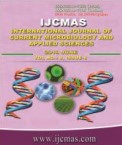


 National Academy of Agricultural Sciences (NAAS)
National Academy of Agricultural Sciences (NAAS)

|
PRINT ISSN : 2319-7692
Online ISSN : 2319-7706 Issues : 12 per year Publisher : Excellent Publishers Email : editorijcmas@gmail.com / submit@ijcmas.com Editor-in-chief: Dr.M.Prakash Index Copernicus ICV 2018: 95.39 NAAS RATING 2020: 5.38 |
Diabetes mellitus (DM) is one of the most common endocrinopathies observed in dogs. The main clinical manifestations are polydipsia, polyuria, polyphagia, weight loss and glucosuria. The etiology of diabetes mellitus is similar in dogs, cats and humans and is probably multifactorial (genetic, immune and environmental factors). Diabetes mellitus is described to be deficiency or absolute lack of insulin secretion is divided into two types: insulin dependent diabetes mellitus (IDDM) and non-insulin dependent diabetes mellitus (NIDDM). Various breed susceptibilities have been reported. Conventionally diagnosis of canine DM was based on persistent fasting hyperglycemia and glucosuria. However, nowadays serum fructosamine, glycated hemoglobin (GHb) and glycated albumin (GA) measurements are used to complement blood glucose concentration for the diagnosis and treatment response monitoring of DM. Traditionally, management of DM is achieved by insulin administration, diet, regular exercise and oral hypoglycemic drugs. Alternate therapies like use of encapsulated islet, gene therapy etc. are being evaluated for its clinical application in the efficient management of DM. This review will briefly summarize our current knowledge about the diagnosis and management of diabetes in dogs.
 |
 |
 |
 |
 |